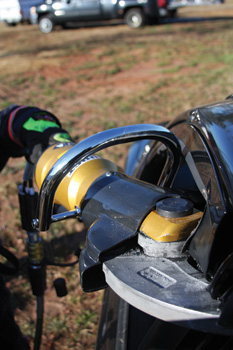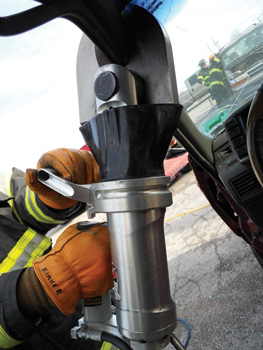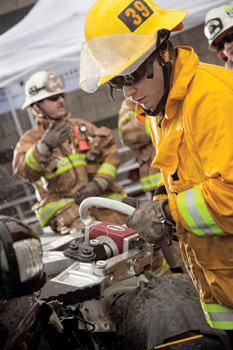Alan M. Petrillo
The makers of hydraulic rescue tools continually seek ways to make their equipment safer, more efficient, and easier to operate for firefighters. Since hydraulic rescue tools have become such integral components on rescue trucks and rescue-pumpers, firefighters want tools that are simple to set up, easy to use, and as lightweight as possible.
Driving Forces in Design
Kevin Halstead, director of rescue sales for Hurst Jaws of Life, says there are two main elements driving the hydraulic rescue tool market these days-the design of motor vehicles that use high-strength steels such as boron and the need for driving force in tools. “We have talked with a lot of the major United States car companies, and in the future they see the use of more high-strength steels,” he says, “using thicker gauges of steel and more layers-maybe four layers instead of only two. So while firefighters might want smaller, lighter, and handier tools, that will be more difficult to do if [vehicle] manufacturers lay on stronger and thicker layers of high-strength steels. It will be harder for [rescue tool] manufacturers to make the tools lighter and smaller.”
 |
| (1) A firefighter uses a Hurst Jaws of Life JL-500 cutter to cut the B-post on a vehicle. (Photo courtesy of Hurst Jaws of Life.) |
Halstead notes that Hurst’s line of 5,000- (JL-500) and 10,000-pound-per-square-inch (psi) S700 (high-pressure) cutting tools, as well as its eDraulic (S700e) battery-operated cutters, currently can handle vehicles that use high-strength steels in their bodies and that Hurst is continually improving all three product lines to keep up with advancing car technology.
But with firefighter requests for lighter tools, there comes a point where the lighter weight becomes self-defeating. “We make lightweight cutters, as do other manufacturers,” Halstead says, “but if you get into a Mercedes-Benz B-post (made of high-strength steel), it will be a struggle with anyone’s lightweight cutter.”
The answer, Halstead believes, lies in new materials that can be incorporated into hydraulic cutting and spreading tools to make them lighter weight. “As new materials become available and are proven through testing, we will make tools lighter than those of today and more portable,” he says.
 |
| (2) This AMK-22 cutter, made by Amkus Inc., is being used to cut a vehicle’s A-post. (Photo courtesy of Amkus Inc.) |
Focus on Cutting Technology
Fran Dunigan, marketing manager for Holmatro Inc., agrees that because carmakers are reinforcing automobile bodies with high-strength steels, the focus of rescue tool manufacturers must be more on cutting technology. “The focus used to be on spreaders and pumps, but now the biggest challenge our customers face is cutting the stronger vehicles that automobile manufacturers are putting on the road,” Dunigan says.
But at the same time Holmatro is seeking to improve cutting technology, Dunigan says it is also looking for ways to make its tools lighter, faster, and easier to use. “A key in the design and development of a hydraulic rescue tool is its ability to be mobile, lightweight without sacrificing power, and able to operate continuously either with a rapid charge or through a hot-swap battery,” he says.
Dunigan notes that Holmatro is looking into new battery technology for its battery tools. “Lithium ion batteries are available that have incredible power, are long duration, are lightweight, and are rapid-charging,” he says. “That’s where battery technology is going, and we think we will be offering a tool run by a lithium ion battery very soon.”
Battery Use Growing
Halstead points out that batteries on tools in other industries have become so reliable that “battery-powered tools have become the tools of choice on construction sites where you don’t see any electrical cords any more. You can get an hour of full power before having to change batteries.” He believes there’s a place for a battery-operated hydraulic tool in the fire-rescue market. “Battery technology is the second fastest growing generation-to-generation product, after computers,” Halstead says. “In fact, our S700e eDraulic tool has the same rating as our S700 high-pressure tool.”
Single-Line Tools
Another positive element in hydraulic rescue tool design, Dunigan maintains, is the development of single-line and single-coupler hydraulic hose, which he notes Holmatro introduced in 2005. “It allows the user to switch tools at the end of the line without going back to the power unit,” Dunigan says. “That was a major benefit of our CORE Technology® introduction into the market.”
Power Units
Chuck Sheaffer, sales manager for Amkus Inc., says his company continues to work on better-performing power units. “The power of the tool is not everything,” Sheaffer says, “but performance of the pump is so very important to how a tool will perform.” Sheaffer says Amkus makes two models of hydraulic tool pumps: the Ultimate and the 240SS. “Our 240SS is an advanced system with an LED display,” he says. “The customer can even troubleshoot the system over the phone if necessary by telling us what’s on the display.”
 |
| (3) A firefighter uses this Champion Spreading tool on a late-model Volvo. (Photo courtesy of Champion Rescue Tools.) |
Sheaffer agrees that firefighters are looking for easier-to-use and faster hydraulic rescue systems. “How fast your system builds up pressure and the lengths of hose you use are important elements in the system,” he says. “Performance degrades the farther out you go with the hose.”
Amkus increases the hydraulic flow in its hoses by building up pressure four times faster than a standard portable power unit,” Sheaffer points out. “That means a tool can cut four times faster, which saves time in a rescue.”
He adds that the 240SS is a two-tool system but that the Ultimate system can run from one to six tools simultaneously. The Ultimate typically is installed as an onboard pumping unit, Sheaffer notes, “and can give the same performance through 300 feet of hose as through 20 feet off a standard portable unit. Also, we have worked with truck manufacturers to couple it with generators and foam systems to operate multiple components off the same power PTO.”
Sheaffer points out that he expects Amkus to introduce at least four new portable power units during the next year, including an electric and a mini power unit. “We’re also working on a new, stronger cutter, but there is only so much you can do with existing tool steel materials,” he adds, “so we are considering alternative materials. But we’ve come close to the limitations of what a cutter can cut, because either the cutter will get too heavy or the blades will not be able to handle the force you put out, which could be dangerous.”
Dunigan says that his company introduced a three-stage pump last year “that’s small, lightweight, and portable but with a faster flow rate of hydraulic fluid, which makes tools work faster and extrications go more quickly.” He notes that the SPU 16 hydraulic power unit allows more fluid flow for a wider range of pressures before it encounters enough resistance where it has to slow down to create a higher pressure. “It is also backward-compatible with our existing hydraulic tools, and they will also perform faster using the SPU 16,” he adds.
Holmatro also is using single-hose lines instead of twin lines, Dunigan says. “We encased the high-pressure hose inside of a low-pressure hose, so a firefighter will never be exposed to a high-pressure hoseline,” he says.
 |
| (4) Holmatro’s BCT 4120 combination tool is battery-powered, weighs 34 pounds, and operates at a maximum pressure of 10,500 psi. (Photo courtesy of Holmatro Inc.) |
Steel Remains Challenging
Rick Haynes, president of Champion Rescue Tools, agrees that the use of hardened vehicle posts and laminated and hydroformed metals has made it much more difficult for rescue crews to cut into vehicles. That’s why his company’s Beast has gone through three major evolutions, he says.
“The Beast was the first full-size cutter and spreader that allowed firefighters to pull three pins and switch the head,” Haynes says. “Our second evolution of the Beast was in the power bands and blade design to compensate for stronger metals being used in vehicles, where we developed the batwing or urban search and rescue (USAR) style blade. It’s a laminated tool-steel blade that grabs the post and pulls the tool into what is being cut, keeping the tool from sliding and getting into the power band, or tool notch.”
The third and current evolution is the Super Beast, Haynes says, “that at 10,500-psi puts out a half million pounds of cutting force or 140,000 pounds of spreading force at the back of the spreader.” The spreader uses stainless-steel-investment-cast, heat treated tips, he notes.
Champion makes a single-stage rotary-pump power unit for its tools, powered by either a 6.5- or 3.0-horsepower (hp) Honda gasoline engine or by a five-hp electric motor. Champion also introduced a new tool this year, the Monster RS-11 mini spreader, which, Haynes says, “functions like a full-size spreader but only weighs 27.5 pounds.”
ALAN M. PETRILLO is a Tucson, Arizona-based freelance writer and is a member of the Fire Apparatus & Emergency Equipment editorial advisory board. He served 22 years with the Verdoy (NY) Fire Department, including in the position of chief.

